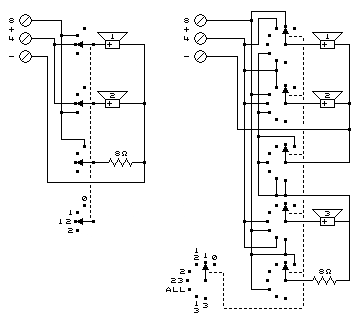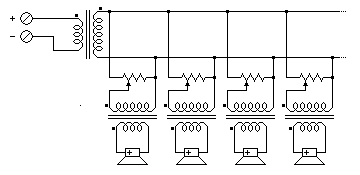
These circuits use ganged rotary switches to select the speakers in use and the proper
impedance loading to the amp.
The circuit on the left uses the 8Ω and 4Ω taps on the amplifier transformer
to provide the proper impedance for two 8Ω speakers. Two speakers are placed in
parallel and connected to the 4Ω output of the amp. An 8Ω resistor loads the
amp when the speakers are turned off for headphone use.
The circuit on the right uses the 8Ω and 4Ω taps on the amplifier transformer
to provide the proper impedance for three 8Ω speakers. Any set of two speakers is
placed in parallel and connected to the 4Ω output of the amp. When all three speakers
are used, the speakers are placed in series-parallel, with an 8Ω resistor used to
make the impedance correct for the 8Ω tap. The same 8Ω resistor loads the
amp when the speakers are turned off for headphone use.
These circuits were used mainly in the 1940s, 1950s, and 1960s when tube amplifiers
were in general use. The advent of low output impedance transistor amplifiers means that
amps are much less load-sensitive. But the minimum impedance the amplifier needs must not
be violated, or the amp may destroy its output transistors.
One difficulty of trying to build these circuits is finding the ganged rotary switches.
Most manufacturers no longer make them.
Passive surround sound adaptors cannot be used with these
circuits.
|


